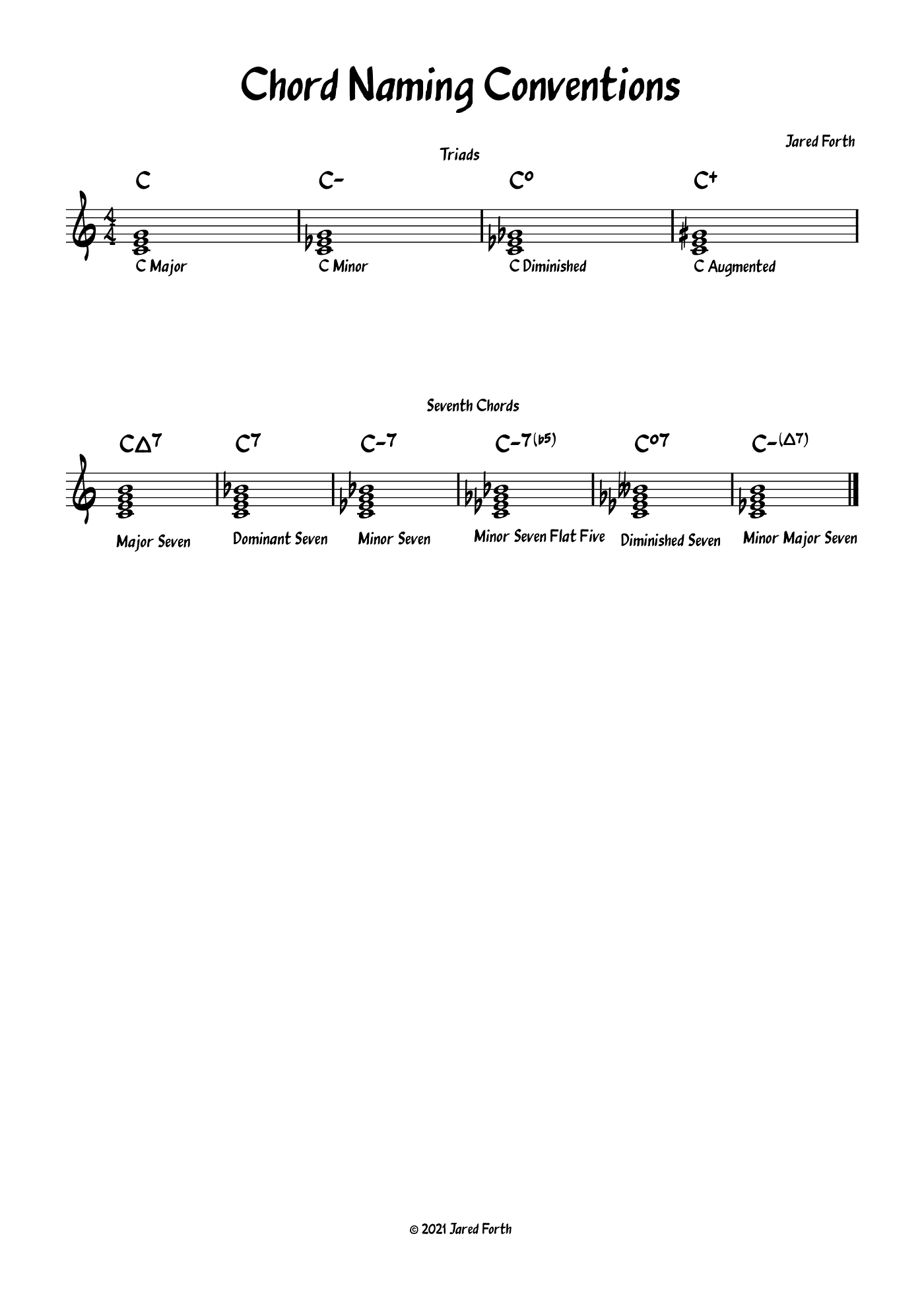Chord Naming Conventions
There are many ways to express chords in jazz, so to avoid confusion I have created a list of the chord types that will be used in this publication. The heuristics I am operating with to form these conventions are maximum understandability regardless of the reader's level and typographical succinctness to minimize space on the page and maximize intelligibility for quick reading. I will list alternate symbols that are commonly used for various chord types as well as the preferred methods of labeling chords in this publication. The image at the bottom presents examples of these conventions on the staff.
Triads
The three triad types are major, minor, diminished, and augmented.
Major Triads
The major triad is spelled root, major third, perfect fifth, so a C major triad would be C, E, G. In our chord naming system, major is implied and has no symbol for a triad. C major would just be written as C.
Minor Triads
The minor triad is spelled root, minor third, perfect fifth, so C minor has the notes C, Eb, G. We are using the minus (-) symbol for minor triads. C minor would be written C-.
Diminished Triads
The diminished triad is spelled root, minor third, flat five. The C diminished triad is C, Eb, Gb. The diminished symbol we are using is o. The C diminished triad is written Co.
Augmented Triads
The augmented triad is spelled root, major third, sharp five, which gives a C augmented of C, E, G#. We will use the plus (+) symbol to denote augmented triads. The C augmented triad would be written C+.
+++
Seventh Chords
Major Seventh Chords
For major seventh chords, I am using the triangle (Δ7) symbol. Other commonly used symbols include maj7, M7, ma7, and Maj7. The major seventh chord is spelled: root, major third, perfect fifth, major seventh. A CΔ7would contain the notes C, E, G, B.
Dominant Seventh Chords
For dominant seventh chords, I am using just 7. This is the only widely used symbol. A dominant seventh chord is spelled: root, major third, perfect fifth, minor (flat) seventh. A C7 has the notes C, E, G, Bb.
Minor Seventh Chords
Minor seventh chords will be notated with -7. Other commonly used symbols include m7 and mi7. The minor seventh is spelled: root, minor third, perfect fifth, minor seventh. A C-7 has the notes C, Eb, G, Bb.
Minor Seven Flat Five (Half-Diminished) Chords
Also known as half-diminished chords, the minor seven flat five will be notated with -7b5. The reason for this is that writing the chord this way is a helpful reminder of how the chord is spelled and that this chord often appears functionally as the ii7b5 in a minor ii-V-I cadence so it should be thought of as an altered m7 chord, not an altered diminished chord. Other commonly used symbols include ø and ø7. The minor seven flat five chord is spelled: root, minor third, flat five, minor seventh. The chord C-7b5 contains the notes C, Eb, Gb, Bb.
Diminished Seventh Chords
Fully diminished seventh chords are notated with °7. This is also sometimes notated as dim7. A fully diminished chord is a stacked series of minor thirds. It is spelled: root, minor third, flat five, double flat seventh (or natural 6). The C°7 contains the notes C, Eb, Gb, Bbb.
Minor Major Seventh Chords
The minor major seventh chord is notated with -(Δ7). Other notations include m(maj7), min(maj7), m(Δ7). The minor major seventh chord is spelled: root, minor third, perfect fifth, major seventh. The C-(Δ7) chord contains the notes C, Eb, G, B.
Augmented Major Seventh Chords
While these are not quite as common as the seventh chord types listed above, I will include them for the sake of completeness. The augmented major seventh chord is notated in this publication with +(Δ7). Other symbols that are common include maj7(#5) and +(M7). An augmented-major seven chord is spelled: root, major third, augmented fifth, major seventh. The C+(Δ7) contains the notes _C, E, G#, B. _
+++
Additional Chord Types
Alterations to a chord will be written in parentheses. Therefore a chord with the notes C, E, G, Bb, Db (C seven flat nine) would be written C7(b9). Non-altered extensions such as the ninth, eleventh, and thirteenth will be added after the chord.
Image Example
The following image presents each of these conventions on the staff.
